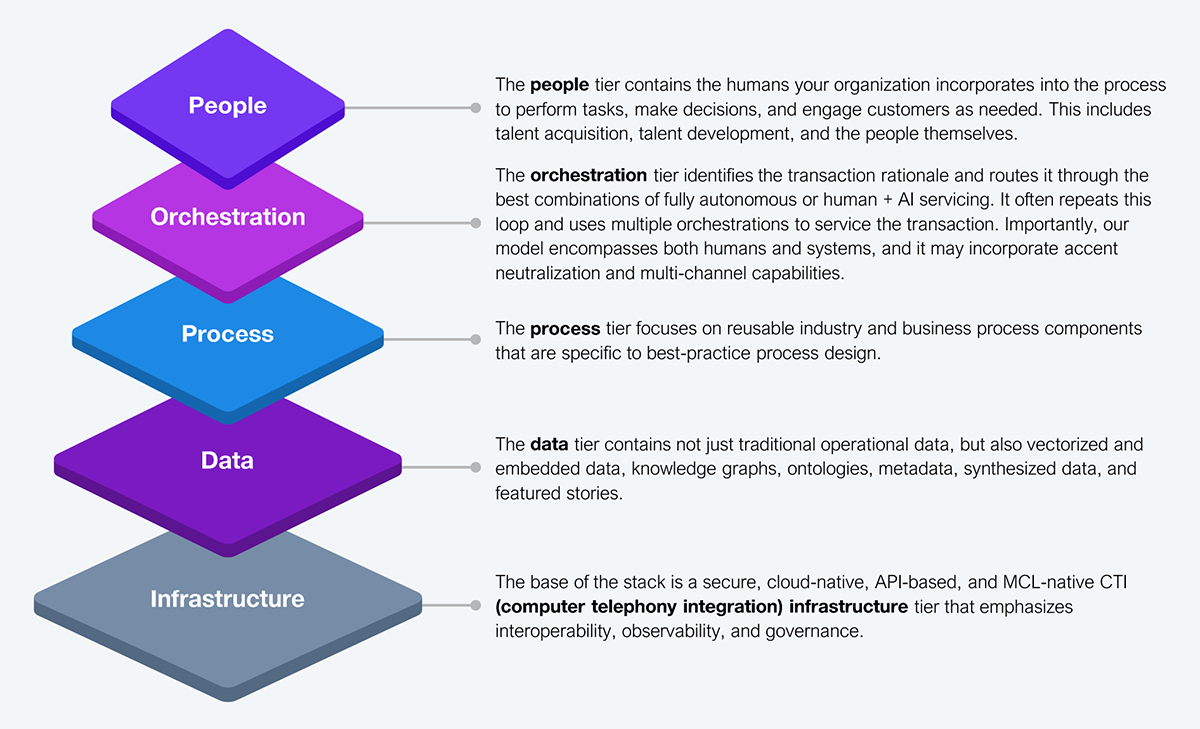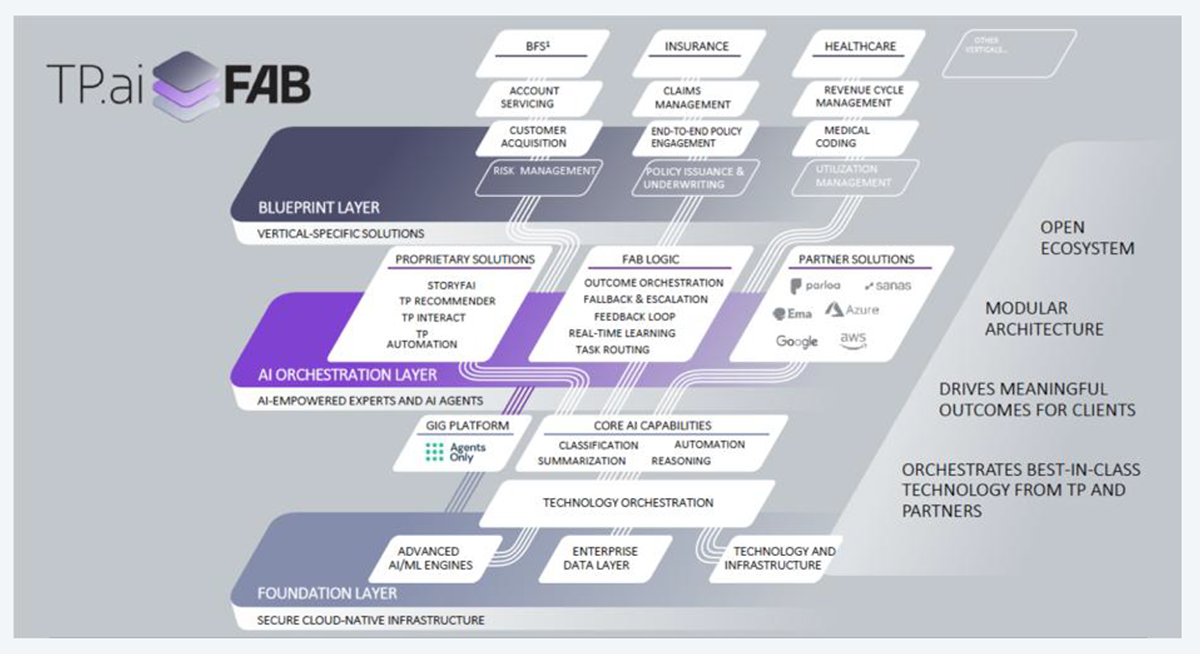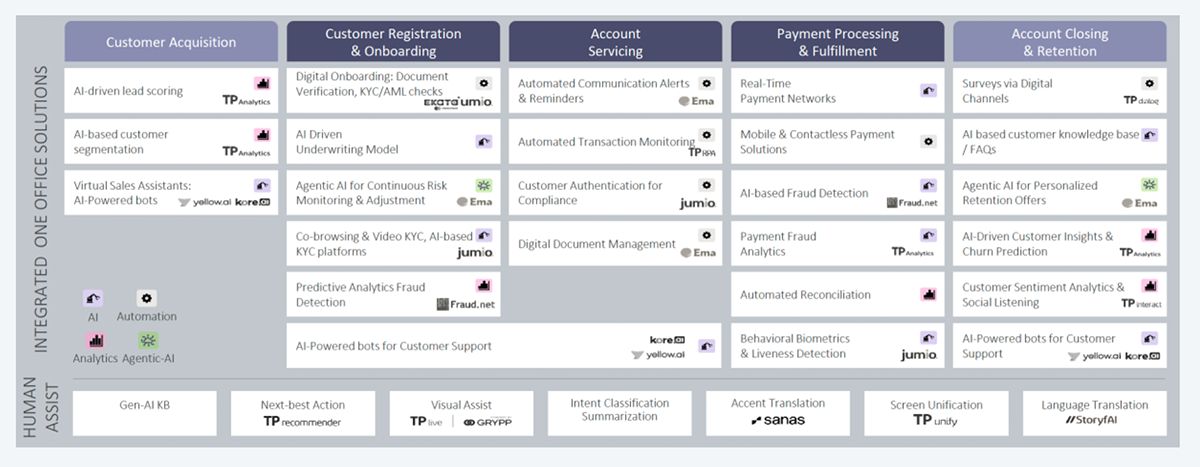The contact center is the crucible of operations management science, but it is a brutally difficult operation and notoriously inconsistent. The Services-as-Software™ (SaS) revolution is poised to change how the customer experience (CX) fundamentally operates and the outcomes it achieves. CX will never be fully automated, but CX delivery leaders still relying on an agent-centric paradigm are anchoring your customer experience in the past. Services-as-Software is breaking the old CX model.
Workforce management statisticians’ “Erlang” staffing plans schedule down to 10-minute intervals. Every recorded transaction is dissected for accuracy and sentiment. Every utterance, keystroke, and pause is recorded and tracked. Despite this analytical focus, contact centers are not the well-oiled machines they could be. Embracing a software-driven approach will change that and will be identifiable by the defining characteristics of a five-tiered architecture.
CX service providers are packaging their operations in software-like stacks of three or four tiers. We think a five-tier system, depicted in Exhibit 1, best reflects the importance of data in agentic frameworks: infrastructure, data, orchestration, process, and people. Visualizing your CX operations like an operating system powerfully combines the human and technology aspects necessary to operate complex CX services.

Source: HFS Research, 2025
TP’s FAB model in Exhibit 2 is a technical example of how service providers formalize this shift by packaging infrastructure, orchestration, and reusable processes into a single, structured architecture. While this is an excellent technical model, we believe a more holistic model is essential, given the importance of humans and data to CX service delivery. CX is a business process where agentic solutions will both be autonomous and work in tandem with staff. The development of human-specific capabilities becomes more essential when implementing agentic solutions. Contact centers will always remain an extremely data-reliant and data-rich environment, thus requiring a robust data strategy.

Source: TP.AI Industry Analyst Day, 2025
Human contact center agents no longer need to service contacts in many situations. Now, fully autonomous, agentic agents, humans, and agent–human hybrids can coordinate to handle transactions that comprise several specialized tasks. For example, an agent could call for order entry and payment agents for help with a transaction.
The orchestration tier is the collaboration logic that enables interactions among humans, autonomous agents, and hybrid solutions. Providers are proving this in practice. For example, TP has specialized agents focused on the narrow capabilities shown in Exhibit 3. Humans are still in the loop, re-positioned into higher-value roles, overseeing orchestration, ensuring quality, and intervening in exceptions.

Source: TP.AI Industry Analyst Day, 2025
Context matters when completing tasks, and specific, reusable best-practice processes form the foundation for autonomous agents designed for narrow tasks, such as authenticating a caller, placing an order, or verifying claim eligibility. Complex single-agent models, which rely on a single agent to complete all tasks in a contact, were the initial trend. However, the CX industry faces complex contacts, often requiring multiple actions to resolve the contact. Our research indicates that the secret sauce behind process excellence is breaking agentic solutions into multiple agents, which enables reusability, allowing enterprises to fine-tune specific activities (such as payment processing or caller authentication) and manage continuous improvement changes, much like custom-developed software. The trick is to build an orchestration layer that leverages multi-agent solutions.
Reusable processes contain incredible intellectual property and are the focus of many CX leaders, technology providers, and service providers. For example, Salesforce launched Agentforce with only 100 use cases, but its list of use cases has since grown substantially. DXC and ServiceNow partnered to build insurance-domain-specific processes. This is moving quickly; TP has already identified 25 processes for the banking industry, including fraud detection, real-time payments, AI-driven unwriting, personalized retention offers, and customer sentiment analysis, showing how to embed best-practice process intellectual property into software-like components.
Few other business processes offer the same opportunity as CX to contract for outcome delivery. By adjusting components in the five-tier architecture, a company can shift toward efficiency, CSAT, NPS, and revenue impact. The quantity of trained agents, seats, and transaction minutes will soon matter far less.
While contact centers’ top concern has always been efficiency and cost takeout, CX leaders have long aspired to the highest quality service, incredible adaptability for new products and customer experiences, and accurate process execution. A step beyond this are mature companies that look at CX as a point of true competitive differentiation and strive to make service a top priority, while looking at every process and function through a customer lens. To truly compete on experience, enterprises must embrace a Services-as-Software model that embeds flexibility, speed, consistency, and scalability at its core:
This isn’t just theory. Providers like TP are already restructuring their delivery models into multi-tier service platforms with infrastructure, orchestration tiers, and vertical templates. Their capabilities very much blend services into software delivery. Enterprise leaders must now demand solutions that meet the performance and functional expectations of each tier of HFS’s Five-Tier Agentic AI Model.
CX is one of the last big cost centers still tied to “human FTE math.” Services-as-Software incinerates that model and lets enterprises contract for clearly measurable outcomes. This means that FTE-driven seat utilization will be replaced with scalable, subscription-like, or per-transaction deal structures. Customers don’t care how you staff and train a contact center. They are about fast, consistent, friendly outcomes. Services-as-Software enable enterprises to roll out personalization at scale, insert differentiation into customer journeys where it matters most, and ensure consistency across channels and geographies.
Enterprise CX leaders must now evaluate their operations and deals not by seat count, but by each tier’s ability. You can no longer cling to old quality and service level agreements (SLAs), which means you’re overpaying for human inconsistency. If your old deal still defines success by seat utilization, agent talk time, and SLA adherence, you’re stuck in a decades-old model. It’s time you evaluate your capability against our recommended five tiers and renegotiate with these capabilities at the core.
Enterprise leaders are hurtling toward a structural reset as CX accelerates its capabilities into the Services-as-Software space. Whereas the old world relied on tenured agents executing SOPs, CX delivered as software shifts not only who performs the actions, but also who owns the operating system of customer service. Enterprise leaders must replace the FTE and seat-count mindset and start building modular, agentic CX platforms that scale, perform expertly, and orchestrate.
While humans will remain at the heart of experience design, exception handling, and empathetic engagement, you’re buying dinosaurs if you’re still buying FTEs and shift interval dashboards. Enterprises leading CX today are building Services-as-Software-powered operating systems.
Register now for immediate access of HFS' research, data and forward looking trends.
Get StartedIf you don't have an account, Register here |
Register now for immediate access of HFS' research, data and forward looking trends.
Get Started